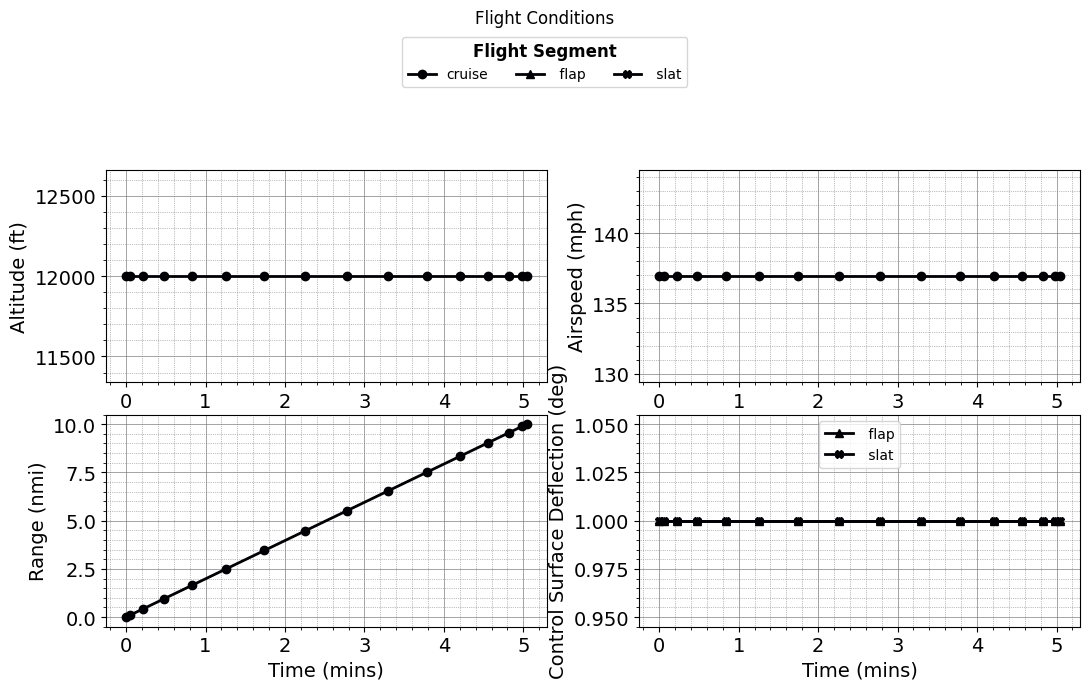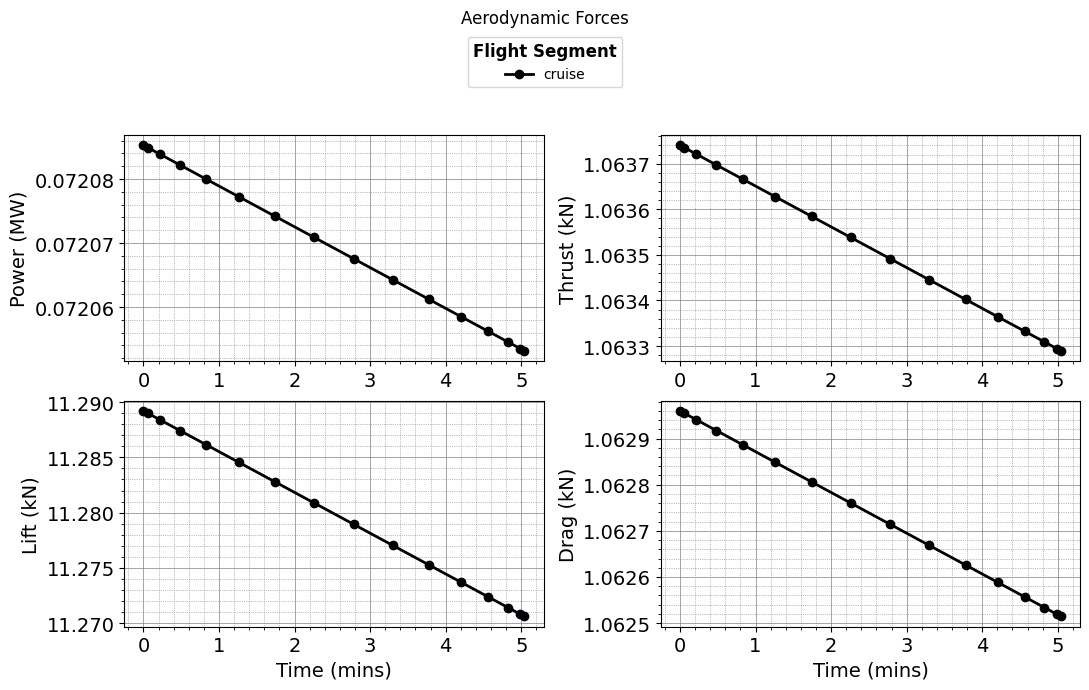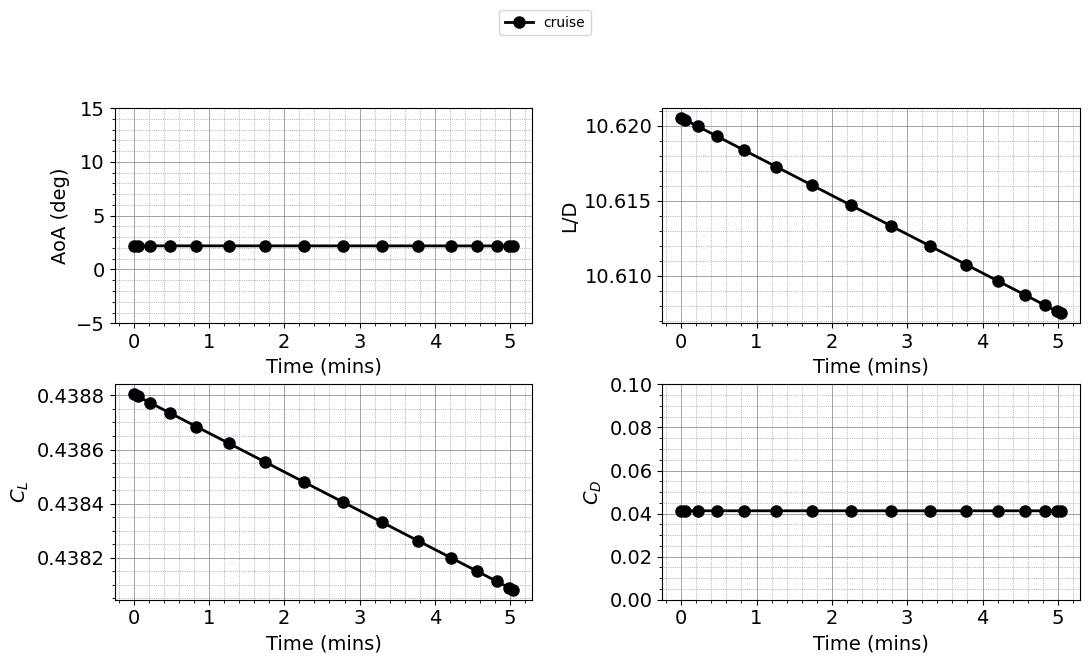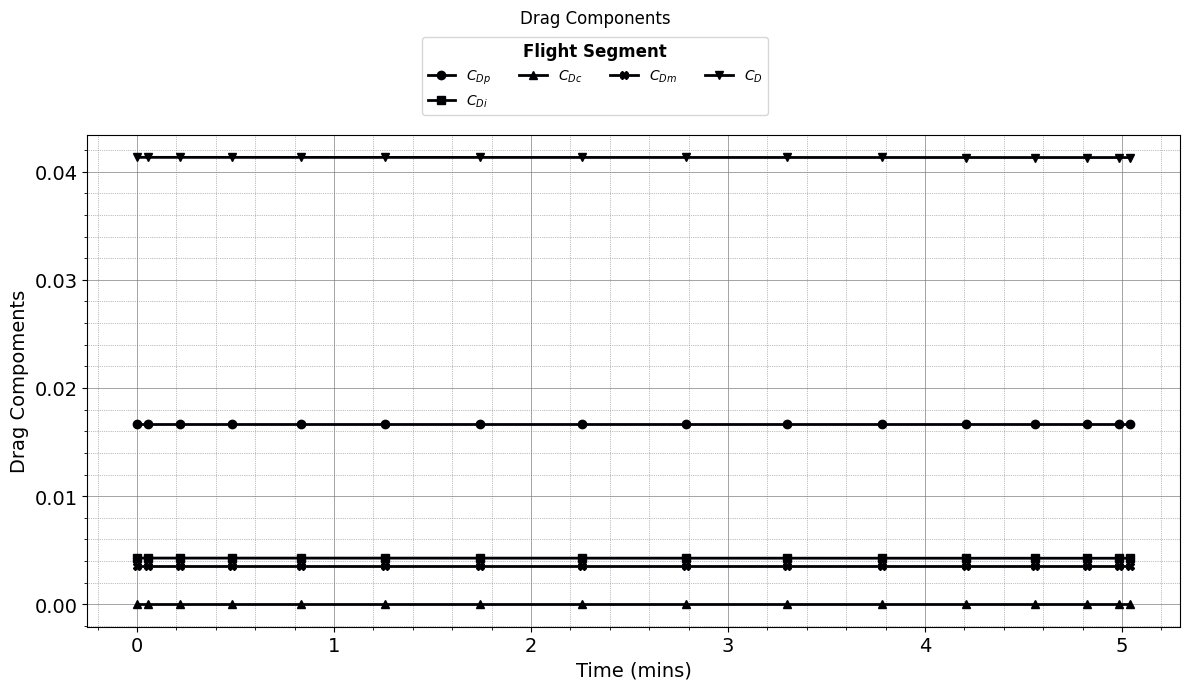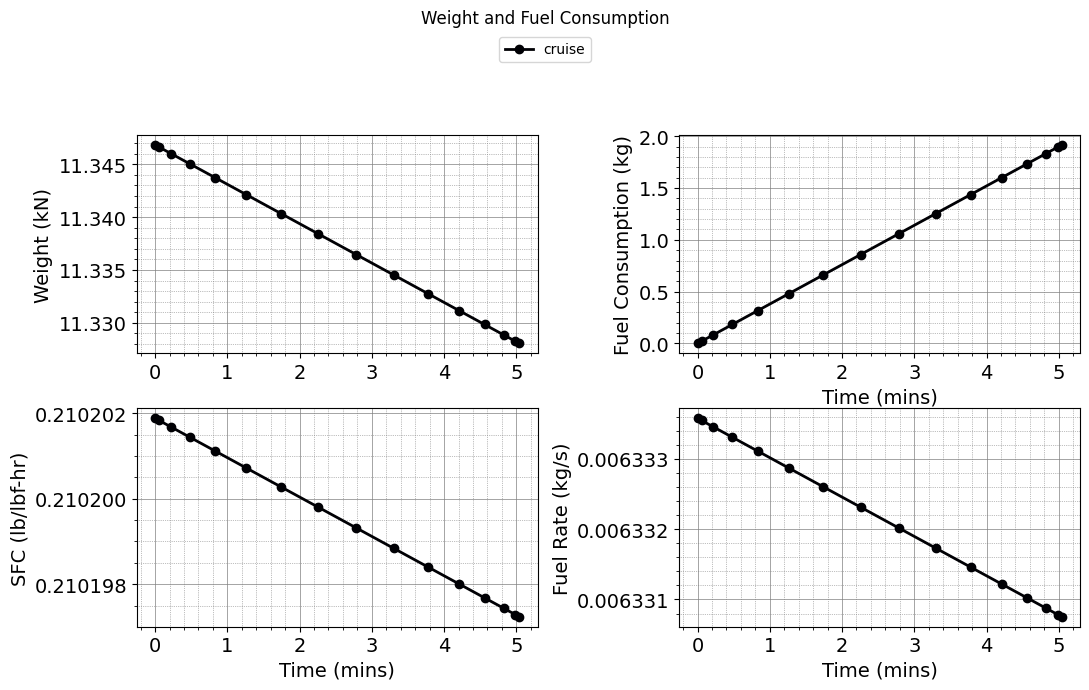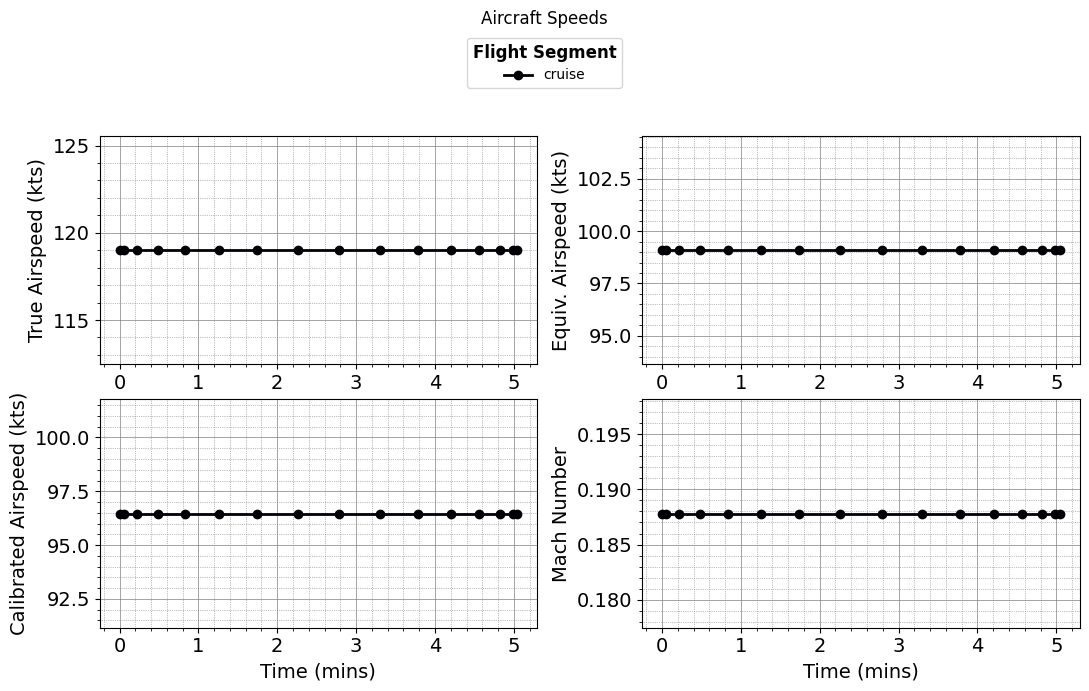Tutorial 4 - General Aircraft Simulation#
Welcome to this tutorial on simulating a general aircraft using RCAIDE. This guide will walk you through the code, explain its components, and highlight where modifications can be made to customize the simulation for different vehicle designs.
1. Header and Imports#
The Imports section is divided into two parts: simulation-specific libraries and general-purpose Python libraries.
The RCAIDE Imports section includes the core modules needed for the simulation. These libraries provide specialized classes and tools for building, analyzing, and running aircraft models.
[1]:
# Cessna_172.py
#
# ----------------------------------------------------------------------
# Imports
# ----------------------------------------------------------------------
import RCAIDE
from RCAIDE.Framework.Core import Units
from RCAIDE.Library.Methods.Powertrain.Converters.Rotor import design_propeller
from RCAIDE.Library.Plots import *
import matplotlib.pyplot as plt
import numpy as np
import os
import sys
sys.path.insert(0,(os.path.dirname(os.getcwd())))
Vehicle Setup#
The ``vehicle_setup`` function defines the baseline configuration of the aircraft. This section builds the vehicle step-by-step by specifying its components, geometric properties, and high-level parameters.
1. Creating the Vehicle Instance#
The setup begins by creating a vehicle instance and assigning it a tag. The tag is a unique string identifier used to reference the vehicle during analysis or in post-processing steps.
2. Defining High-Level Vehicle Parameters#
The high-level parameters describe the aircraft’s key operational characteristics, such as:
Maximum Takeoff Weight: The heaviest allowable weight of the aircraft for safe flight.
Operating Empty Weight: The aircraft weight without fuel, passengers, or payload.
Payload: The weight of cargo and passengers.
Max Zero Fuel Weight: The maximum weight of the aircraft excluding fuel.
Units for these parameters can be converted automatically using the Units module to ensure consistency and reduce errors.
3. Defining the Landing Gear#
Landing gear parameters, such as the number of main and nose wheels, are set for the aircraft. While not used in this tutorial, these values can be applied in advanced analyses, such as ground loads or noise prediction.
4. Main Wing Setup#
The main wing is added using the ``Main_Wing`` class. This designation ensures that the primary lifting surface is recognized correctly by the analysis tools. Key properties of the wing include:
Area: The total wing surface area.
Span: The length of the wing from tip to tip.
Aspect Ratio: A ratio of span to average chord, determining wing efficiency.
Segments: Divisions of the wing geometry (e.g., root and tip sections).
Control Surfaces: High-lift devices like flaps and ailerons, defined by span fractions and deflections.
5. Horizontal and Vertical Stabilizers#
The stabilizers provide stability and control for the aircraft:
Horizontal Stabilizer: Defined using the
Horizontal_Tailclass. It follows a similar setup to the main wing but acts as a stabilizing surface.Vertical Stabilizer: Defined using the
Vertical_Tailclass, with an additional option to designate the tail as a T-tail for weight calculations.
6. Fuselage Definition#
The fuselage is modeled by specifying its geometric parameters, such as:
Length: The overall length of the aircraft body.
Width: The widest part of the fuselage cross-section.
Height: The height of the fuselage.
These values influence drag calculations and overall structural weight.
7. Energy Network#
The energy network models the propulsion system. The energy network determines the engine’s thrust, bypass ratio, and fuel type. These parameters are essential for performance and fuel efficiency analyses.
[2]:
def vehicle_setup():
#------------------------------------------------------------------------------------------------------------------------------------
# ################################################# Vehicle-level Properties ########################################################
#------------------------------------------------------------------------------------------------------------------------------------
vehicle = RCAIDE.Vehicle()
vehicle.tag = 'Cessna_172'
vehicle.mass_properties.max_takeoff = 2550. * Units.pounds
vehicle.mass_properties.takeoff = 2550. * Units.pounds
vehicle.mass_properties.max_zero_fuel = 2550. * Units.pounds
vehicle.mass_properties.cargo = 0.
# envelope properties
vehicle.flight_envelope.ultimate_load = 5.7
vehicle.flight_envelope.positive_limit_load = 3.8
vehicle.flight_envelope.design_range = 750 * Units.nmi
vehicle.flight_envelope.design_dynamic_pressure = 1929.1574740443007
vehicle.flight_envelope.design_mach_number = 0.18745866156304694
cruise_speed = 124. * Units.kts
altitude = 8500. * Units.ft
atmo = RCAIDE.Framework.Analyses.Atmospheric.US_Standard_1976()
freestream = atmo.compute_values (0.)
freestream0 = atmo.compute_values (altitude)
mach_number = (cruise_speed/freestream.speed_of_sound)[0][0]
vehicle.design_dynamic_pressure = ( .5 *freestream0.density*(cruise_speed*cruise_speed))[0][0]
vehicle.flight_envelope.design_mach_number = mach_number
# basic parameters
vehicle.reference_area = 174. * Units.feet**2
vehicle.passengers = 4
#------------------------------------------------------------------------------------------------------------------------------------
# ##################################################### Landing Gear ################################################################
#------------------------------------------------------------------------------------------------------------------------------------
main_gear = RCAIDE.Library.Components.Landing_Gear.Main_Landing_Gear()
main_gear.strut_length = 12. * Units.inches
vehicle.append_component(main_gear)
nose_gear = RCAIDE.Library.Components.Landing_Gear.Nose_Landing_Gear()
nose_gear.strut_length = 6. * Units.inches
vehicle.append_component(nose_gear)
#------------------------------------------------------------------------------------------------------------------------------------
# ######################################################## Wings ####################################################################
#------------------------------------------------------------------------------------------------------------------------------------
# ------------------------------------------------------------------
# Main Wing
# ------------------------------------------------------------------
wing = RCAIDE.Library.Components.Wings.Main_Wing()
wing.tag = 'main_wing'
wing.sweeps.quarter_chord = 0.0 * Units.deg
wing.thickness_to_chord = 0.12
wing.areas.reference = 174. * Units.feet**2
wing.spans.projected = 36. * Units.feet + 1. * Units.inches
wing.chords.root = 66. * Units.inches
wing.chords.tip = 45. * Units.inches
wing.chords.mean_aerodynamic = 58. * Units.inches
wing.taper = wing.chords.tip/wing.chords.root
wing.aspect_ratio = wing.spans.projected**2. / wing.areas.reference
wing.twists.root = 3.0 * Units.degrees
wing.twists.tip = 1.5 * Units.degrees
wing.origin = [[80.* Units.inches,0,0]]
wing.aerodynamic_center = [22.* Units.inches,0,0]
wing.vertical = False
wing.symmetric = True
wing.high_lift = True
wing.dynamic_pressure_ratio = 1.0
# control surfaces -------------------------------------------
flap = RCAIDE.Library.Components.Wings.Control_Surfaces.Flap()
flap.tag = 'flap'
flap.span_fraction_start = 0.15
flap.span_fraction_end = 0.324
flap.deflection = 1.0 * Units.deg
flap.chord_fraction = 0.19
wing.append_control_surface(flap)
slat = RCAIDE.Library.Components.Wings.Control_Surfaces.Slat()
slat.tag = 'slat'
slat.span_fraction_start = 0.324
slat.span_fraction_end = 0.963
slat.deflection = 1.0 * Units.deg
slat.chord_fraction = 0.1
wing.append_control_surface(slat)
RCAIDE.Library.Methods.Geometry.Planform.wing_planform(wing)
# add to vehicle
vehicle.append_component(wing)
# ------------------------------------------------------------------
# Horizontal Stabilizer
# ------------------------------------------------------------------
wing = RCAIDE.Library.Components.Wings.Horizontal_Tail()
wing.tag = 'horizontal_stabilizer'
wing.sweeps.quarter_chord = 0.0 * Units.deg
wing.thickness_to_chord = 0.12
wing.areas.reference = 5800. * Units.inches**2
wing.spans.projected = 136. * Units.inches
wing.chords.root = 55. * Units.inches
wing.chords.tip = 30. * Units.inches
wing.chords.mean_aerodynamic = 43. * Units.inches
wing.taper = wing.chords.tip/wing.chords.root
wing.aspect_ratio = wing.spans.projected**2. / wing.areas.reference
wing.twists.root = 0.0 * Units.degrees
wing.twists.tip = 0.0 * Units.degrees
wing.origin = [[246.* Units.inches,0,0]]
wing.aerodynamic_center = [20.* Units.inches,0,0]
wing.vertical = False
wing.symmetric = True
wing.high_lift = False
wing.dynamic_pressure_ratio = 0.9
vehicle.append_component(wing)
# ------------------------------------------------------------------
# Vertical Stabilizer
# ------------------------------------------------------------------
wing = RCAIDE.Library.Components.Wings.Vertical_Tail()
wing.tag = 'vertical_stabilizer'
wing.sweeps.quarter_chord = 25. * Units.deg
wing.thickness_to_chord = 0.12
wing.areas.reference = 3500. * Units.inches**2
wing.spans.projected = 73. * Units.inches
wing.chords.root = 66. * Units.inches
wing.chords.tip = 27. * Units.inches
wing.chords.mean_aerodynamic = 48. * Units.inches
wing.taper = wing.chords.tip/wing.chords.root
wing.aspect_ratio = wing.spans.projected**2. / wing.areas.reference
wing.twists.root = 0.0 * Units.degrees
wing.twists.tip = 0.0 * Units.degrees
wing.origin = [[237.* Units.inches,0,0]]
wing.aerodynamic_center = [20.* Units.inches,0,0]
wing.vertical = True
wing.symmetric = False
wing.t_tail = False
wing.dynamic_pressure_ratio = 1.0
# add to vehicle
vehicle.append_component(wing)
#------------------------------------------------------------------------------------------------------------------------------------
# ########################################################## Fuselage ###############################################################
#------------------------------------------------------------------------------------------------------------------------------------
fuselage = RCAIDE.Library.Components.Fuselages.Tube_Fuselage()
fuselage.number_coach_seats = 4.
fuselage.differential_pressure = 8*Units.psi # Maximum differential pressure
fuselage.width = 42. * Units.inches # Width of the fuselage
fuselage.heights.maximum = 62. * Units.inches # Height of the fuselage
fuselage.lengths.total = 326. * Units.inches # Length of the fuselage
fuselage.lengths.tail = 161. * Units.inches
fuselage.lengths.cabin = 105. * Units.inches
fuselage.mass_properties.volume = .4*fuselage.lengths.total*(np.pi/4.)*(fuselage.heights.maximum**2.) #try this as approximation
fuselage.mass_properties.internal_volume = .3*fuselage.lengths.total*(np.pi/4.)*(fuselage.heights.maximum**2.)
fuselage.areas.wetted = 30000. * Units.inches**2.
fuselage.seats_abreast = 2.
fuselage.fineness.nose = 1.6
fuselage.fineness.tail = 2.
fuselage.lengths.nose = 60. * Units.inches
fuselage.heights.at_quarter_length = 62. * Units.inches
fuselage.heights.at_three_quarters_length = 62. * Units.inches
fuselage.heights.at_wing_root_quarter_chord = 23. * Units.inches
fuselage.areas.front_projected = fuselage.width* fuselage.heights.maximum
fuselage.effective_diameter = 50. * Units.inches
# add to vehicle
vehicle.append_component(fuselage)
#------------------------------------------------------------------------------------------------------------------------------------
# ########################################################## Energy Network #########################################################
#------------------------------------------------------------------------------------------------------------------------------------
#initialize the fuel network
net = RCAIDE.Framework.Networks.Fuel()
# add the network to the vehicle
vehicle.append_energy_network(net)
#------------------------------------------------------------------------------------------------------------------------------------
# Bus
#------------------------------------------------------------------------------------------------------------------------------------
fuel_line = RCAIDE.Library.Components.Powertrain.Distributors.Fuel_Line()
#------------------------------------------------------------------------------------------------------------------------------------
# Fuel Tank & Fuel
#------------------------------------------------------------------------------------------------------------------------------------
fuel_tank = RCAIDE.Library.Components.Powertrain.Sources.Fuel_Tanks.Fuel_Tank()
fuel_tank.origin = vehicle.wings.main_wing.origin
fuel_tank.fuel = RCAIDE.Library.Attributes.Propellants.Aviation_Gasoline()
fuel_tank.fuel.mass_properties.mass = 319 *Units.lbs
fuel_tank.mass_properties.center_of_gravity = wing.mass_properties.center_of_gravity
fuel_tank.volume = fuel_tank.fuel.mass_properties.mass/fuel_tank.fuel.density
fuel_line.fuel_tanks.append(fuel_tank)
#------------------------------------------------------------------------------------------------------------------------------------
# Propulsor
#------------------------------------------------------------------------------------------------------------------------------------
ice_prop = RCAIDE.Library.Components.Powertrain.Propulsors.Internal_Combustion_Engine()
ice_prop.active_fuel_tanks = ['fuel_tank']
# Engine
engine = RCAIDE.Library.Components.Powertrain.Converters.Engine()
engine.sea_level_power = 180. * Units.horsepower
engine.flat_rate_altitude = 0.0
engine.rated_speed = 2700. * Units.rpm
engine.power_specific_fuel_consumption = 0.52 * Units['lb/hp/hr']
ice_prop.engine = engine
# Propeller
prop = RCAIDE.Library.Components.Powertrain.Converters.Propeller()
prop.tag = 'propeller'
prop.number_of_blades = 2.0
prop.tip_radius = 76./2. * Units.inches
prop.hub_radius = 8. * Units.inches
prop.cruise.design_freestream_velocity = 119. * Units.knots
prop.cruise.design_angular_velocity = 2650. * Units.rpm
prop.cruise.design_Cl = 0.8
prop.cruise.design_altitude = 12000. * Units.feet
prop.cruise.design_power = .64 * 180. * Units.horsepower
prop.variable_pitch = True
ospath = os.path.abspath(os.path.join('Notebook'))
separator = os.path.sep
rel_path = os.path.dirname(ospath) + separator + '..' + separator + '..' + separator + 'VnV' + separator + 'Vehicles' + separator
airfoil = RCAIDE.Library.Components.Airfoils.Airfoil()
airfoil.tag = 'NACA_4412'
airfoil.coordinate_file = rel_path + 'Airfoils' + separator + 'NACA_4412.txt' # absolute path
airfoil.polar_files =[ rel_path + 'Airfoils' + separator + 'Polars' + separator + 'NACA_4412_polar_Re_50000.txt',
rel_path + 'Airfoils' + separator + 'Polars' + separator + 'NACA_4412_polar_Re_100000.txt',
rel_path + 'Airfoils' + separator + 'Polars' + separator + 'NACA_4412_polar_Re_200000.txt',
rel_path + 'Airfoils' + separator + 'Polars' + separator + 'NACA_4412_polar_Re_500000.txt',
rel_path + 'Airfoils' + separator + 'Polars' + separator + 'NACA_4412_polar_Re_1000000.txt']
prop.append_airfoil(airfoil)
prop.airfoil_polar_stations = [0,0,0,0,0,0,0,0,0,0,0,0,0,0,0,0,0,0,0,0]
design_propeller(prop)
ice_prop.propeller = prop
net.propulsors.append(ice_prop)
#------------------------------------------------------------------------------------------------------------------------------------
# Assign propulsors to fuel line to network
fuel_line.assigned_propulsors = [[ice_prop.tag]]
#------------------------------------------------------------------------------------------------------------------------------------
# Append fuel line to fuel line to network
net.fuel_lines.append(fuel_line)
#------------------------------------------------------------------------------------------------------------------------------------
# Avionics
#------------------------------------------------------------------------------------------------------------------------------------
Wuav = 2. * Units.lbs
avionics = RCAIDE.Library.Components.Powertrain.Systems.Avionics()
avionics.mass_properties.uninstalled = Wuav
vehicle.avionics = avionics
#------------------------------------------------------------------------------------------------------------------------------------
# Vehicle Definition Complete
#------------------------------------------------------------------------------------------------------------------------------------
return vehicle
Configurations Setup#
The ``configs_setup`` function defines the different vehicle configurations (referred to as configs) used during the simulation. Configurations allow for modifications to the baseline vehicle, such as altering control surface settings, without redefining the entire vehicle.
1. Base Configuration#
The base configuration serves as the foundation for all other configurations. It is defined to match the baseline vehicle created in the vehicle_setup function. Configurations in RCAIDE are created as containers using RCAIDE Data classes. These classes provide additional functionality, such as the ability to append new configurations or modifications.
2. Cruise Configuration#
The cruise configuration demonstrates that new configurations can inherit properties directly from existing configurations (e.g., the base config). This avoids redundancy and ensures consistency across configurations.
The cruise configuration typically reflects the clean flight condition, with no high-lift devices like flaps or slats deployed.
3. Takeoff Configuration#
The takeoff configuration is the first configuration that introduces changes to the baseline vehicle. It shows how specific vehicle parameters, such as flap and slat settings, can be modified. For example:
Flap Deflection: Flaps are deployed to increase lift during takeoff.
Slat Deployment: Slats may also be deployed to improve low-speed aerodynamic performance.
This highlights the flexibility of vehicle configurations for different phases of flight.
4. Remaining Configurations#
The remaining configurations, such as climb, approach, and landing, follow a similar pattern:
Landing: Maximum flap and slat deflection for increased lift and drag, enabling a controlled descent and touchdown.
Each configuration is built upon the previous one or the base configuration, ensuring modularity and easy customization.
[3]:
def configs_setup(vehicle):
# ------------------------------------------------------------------
# Initialize Configurations
# ------------------------------------------------------------------
configs = RCAIDE.Library.Components.Configs.Config.Container()
base_config = RCAIDE.Library.Components.Configs.Config(vehicle)
base_config.tag = 'base'
configs.append(base_config)
# ------------------------------------------------------------------
# Cruise Configuration
# ------------------------------------------------------------------
config = RCAIDE.Library.Components.Configs.Config(base_config)
config.tag = 'cruise'
configs.append(config)
# ------------------------------------------------------------------
# Takeoff Configuration
# ------------------------------------------------------------------
config = RCAIDE.Library.Components.Configs.Config(base_config)
config.tag = 'takeoff'
config.wings['main_wing'].control_surfaces.flap.deflection = 20. * Units.deg
config.V2_VS_ratio = 1.21
config.maximum_lift_coefficient = 2.
configs.append(config)
# ------------------------------------------------------------------
# Landing Configuration
# ------------------------------------------------------------------
config = RCAIDE.Library.Components.Configs.Config(base_config)
config.tag = 'landing'
config.wings['main_wing'].control_surfaces.flap.deflection = 20. * Units.deg
config.Vref_VS_ratio = 1.23
config.maximum_lift_coefficient = 2.
configs.append(config)
# done!
return configs
Base Analysis#
The ``base_analysis`` function defines the analyses required for evaluating the aircraft. Each analysis addresses a specific aspect of the vehicle’s performance or characteristics. Below are the key analyses, their purpose, and considerations for their use.
1. Weights Analysis#
The weights analysis calculates the distribution of the aircraft’s weight across various components. This method is based on empirical correlations designed for tube-and-wing transport aircraft configurations.
Provides a breakdown of component weights (e.g., wings, fuselage, engines).
While informative, the results of this analysis are not directly used in the performance evaluation.
2. Aerodynamics Analysis#
The aerodynamics analysis evaluates the aerodynamic performance of the aircraft. It uses RCAIDE’s fidelity zero method:
Fidelity Zero: This is RCAIDE’s baseline aerodynamic analysis method, suitable for subsonic transport aircraft.
Similar to aerodynamic methods found in conceptual design texts.
Provides estimates for lift, drag, and other aerodynamic coefficients.
Note: Higher-fidelity aerodynamic methods are available for more detailed analyses if needed.
3. Stability Analysis#
The stability analysis calculates stability derivatives for the aircraft. While it is not used in the current mission setup, it can be run post-mission for checks or additional analysis.
Like the aerodynamic method, it uses fidelity zero for baseline stability analysis.
Applicable for basic stability checks of subsonic transport aircraft.
4. Energy Analysis#
The energy analysis runs the energy network attached to the vehicle. For this turboprop-powered aircraft:
The analysis evaluates the turboprop energy network.
Ensures the propulsion system behavior, such as thrust and fuel consumption, is accounted for.
5. Planet Analysis#
The planet analysis defines the planetary environment the vehicle operates in. This setup allows for the attachment of an atmospheric model.
6. Atmosphere Analysis#
The atmosphere analysis sets the atmospheric conditions for the simulation. A common choice is the US 1976 Standard Atmosphere, which provides:
Standard temperature, pressure, and density profiles with altitude.
Consistent atmospheric conditions for performance evaluations.
[4]:
def base_analysis(vehicle):
# ------------------------------------------------------------------
# Initialize the Analyses
# ------------------------------------------------------------------
analyses = RCAIDE.Framework.Analyses.Vehicle()
# ------------------------------------------------------------------
# Weights
weights = RCAIDE.Framework.Analyses.Weights.Conventional()
weights.aircraft_type = 'General_Aviation'
weights.vehicle = vehicle
analyses.append(weights)
# ------------------------------------------------------------------
# Aerodynamics Analysis
# Calculate extra drag from landing gear:
main_wheel_width = 4. * Units.inches
main_wheel_height = 12. * Units.inches
nose_gear_height = 10. * Units.inches
nose_gear_width = 4. * Units.inches
total_wheel = 2 * main_wheel_width*main_wheel_height + nose_gear_width*nose_gear_height
main_gear_strut_height = 2. * Units.inches
main_gear_strut_length = 24. * Units.inches
nose_gear_strut_height = 12. * Units.inches
nose_gear_strut_width = 2. * Units.inches
total_strut = 2 * main_gear_strut_height*main_gear_strut_length + nose_gear_strut_height*nose_gear_strut_width
drag_area = 1.4*( total_wheel + total_strut)
aerodynamics = RCAIDE.Framework.Analyses.Aerodynamics.Vortex_Lattice_Method()
aerodynamics.vehicle = vehicle
aerodynamics.settings.drag_coefficient_increment = 1.0*drag_area/vehicle.reference_area
analyses.append(aerodynamics)
# ------------------------------------------------------------------
# Energy
energy= RCAIDE.Framework.Analyses.Energy.Energy()
energy.vehicle = vehicle
analyses.append(energy)
# ------------------------------------------------------------------
# Planet Analysis
planet = RCAIDE.Framework.Analyses.Planets.Earth()
analyses.append(planet)
# ------------------------------------------------------------------
# Atmosphere Analysis
atmosphere = RCAIDE.Framework.Analyses.Atmospheric.US_Standard_1976()
atmosphere.features.planet = planet.features
analyses.append(atmosphere)
return analyses
Analyses Setup#
The ``analyses_setup`` function assigns a set of analyses to each vehicle configuration. Analyses are used to evaluate the aircraft’s performance, aerodynamics, energy systems, and other characteristics for a given configuration.
1. Overview of Analyses Assignment#
In this tutorial, all configurations share the same set of analyses. However, this function provides the flexibility to assign a unique set of analyses to any specific configuration.
2. Purpose of Analyses Assignment#
The analyses ensure that the defined vehicle configurations (e.g., cruise, takeoff, landing) are evaluated correctly during the simulation. Each configuration can have:
Common Analyses: Shared across multiple configurations for simplicity.
Custom Analyses: Tailored to a specific phase of flight or performance evaluation.
3. Typical Analyses Included#
The following analyses are typically assigned to each configuration:
Weights Analysis: Computes weight distribution across components.
Aerodynamics Analysis: Estimates lift, drag, and aerodynamic coefficients.
Stability Analysis: Evaluates stability derivatives for flight control assessments.
Energy Analysis: Runs the energy network (e.g., turboprop engine) for thrust and fuel performance.
Atmosphere Analysis: Sets atmospheric conditions using standard atmospheric models.
By assigning these analyses, the vehicle’s behavior under different configurations (e.g., cruise, takeoff, landing) can be comprehensively evaluated.
4. Customizing Analyses#
To assign a custom analysis set for a specific configuration:
Define a new analysis function tailored to the desired evaluation.
Replace the default analyses for the target configuration by calling the custom function.
For example, the takeoff configuration might use a modified aerodynamic analysis to account for flap and slat deployment.
[5]:
def analyses_setup(configs):
analyses = RCAIDE.Framework.Analyses.Analysis.Container()
# build a base analysis for each config
for tag,config in configs.items():
analysis = base_analysis(config)
analyses[tag] = analysis
return analyses
Mission Setup#
The ``mission_setup`` function defines the mission profile used to compute the aircraft’s performance. A mission profile consists of sequential segments that represent different phases of flight, such as climb, cruise, and descent.
1. Mission Profile Overview#
A mission profile is made up of individual flight segments. Each segment specifies the aircraft’s flight conditions, such as:
Altitude
Speed
Range
Time
These segments are simulated sequentially, allowing for a detailed performance analysis of the vehicle across all phases of flight.
2. Segments in the Mission Profile#
Cruise: Level flight at a constant altitude and speed for fuel-efficient operation.
Each segment defines specific performance conditions and parameters, such as speed, altitude, and duration.
For more information on the mission solver and its implementation, refer to the relevant RCAIDE documentation.
[6]:
# ----------------------------------------------------------------------
# Define the Mission
# ----------------------------------------------------------------------
def mission_setup(analyses):
# ------------------------------------------------------------------
# Initialize the Mission
# ------------------------------------------------------------------
mission = RCAIDE.Framework.Mission.Sequential_Segments()
mission.tag = 'the_mission'
# unpack Segments module
Segments = RCAIDE.Framework.Mission.Segments
# base segment
base_segment = Segments.Segment()
# ------------------------------------------------------------------
# Cruise Segment: Constant Speed Constant Altitude
# ------------------------------------------------------------------
segment = Segments.Cruise.Constant_Speed_Constant_Altitude(base_segment)
segment.tag = "cruise"
segment.analyses.extend( analyses.base )
segment.altitude = 12000. * Units.feet
segment.air_speed = 119. * Units.knots
segment.distance = 10 * Units.nautical_mile
segment.state.numerics.number_control_points = 4
# define flight dynamics to model
segment.flight_dynamics.force_x = True
segment.flight_dynamics.force_z = True
# define flight controls
segment.assigned_control_variables.throttle.active = True
segment.assigned_control_variables.throttle.assigned_propulsors = [['ice_propeller']]
segment.assigned_control_variables.body_angle.active = True
mission.append_segment(segment)
return mission
Missions Setup#
The missions_setup function is responsible for setting up a list of missions. This allows multiple missions to be incorporated if desired, but only one is used here.
Initialize Missions Object: It creates an empty
Missionsobject from theRCAIDE.Framework.Missionmodule.Tag the Mission: It assigns the tag
'base_mission'to the providedmissionobject. This tag is used to identify the mission.Add Mission to List: It adds the tagged
missionto theMissionsobject.Return Missions Object: Finally, it returns the
Missionsobject, which now contains the tagged mission.
[7]:
def missions_setup(mission):
missions = RCAIDE.Framework.Mission.Missions()
# base mission
mission.tag = 'base_mission'
missions.append(mission)
return missions
Plot Mission#
The last function in this file is used to plot the performance results from the mission evaluation. The results shown are not an exhaustive list of RCAIDE outputs, and custom plotting routines can be created.
[8]:
# ----------------------------------------------------------------------
# Plot Mission
# ----------------------------------------------------------------------
def plot_mission(results):
# Plot Flight Conditions
plot_flight_conditions(results)
# Plot Aerodynamic Forces
plot_aerodynamic_forces(results)
# Plot Aerodynamic Coefficients
plot_aerodynamic_coefficients(results)
# Drag Components
plot_drag_components(results)
# Plot Altitude, sfc, vehicle weight
plot_altitude_sfc_weight(results)
# Plot Velocities
plot_aircraft_velocities(results)
return
Main Script#
The main script is used to call each of the functions defined above to execute the mission. A main script is used to run the functions for increased readability and maintainability.
[9]:
# vehicle data
vehicle = vehicle_setup()
# Set up vehicle configs
configs = configs_setup(vehicle)
# create analyses
analyses = analyses_setup(configs)
# mission analyses
mission = mission_setup(analyses)
# create mission instances (for multiple types of missions)
missions = missions_setup(mission)
# mission analysis
results = missions.base_mission.evaluate()
plot_mission(results)
Performing Weights Analysis
--------------------------------------------------------
Propulsion Architecture: Conventional
Aircraft Type : General_Aviation
Method : FLOPS
Aircraft operating empty weight will be overwritten
Aircraft center of gravity location will be overwritten
Aircraft moment of intertia tensor will be overwritten
Mission Solver Initiated
0%| | 0/100 [00:00<?, ?it/s]
Solving cruise segment.
100%|██████████| 100/100 [00:30<00:00, 3.24it/s]
